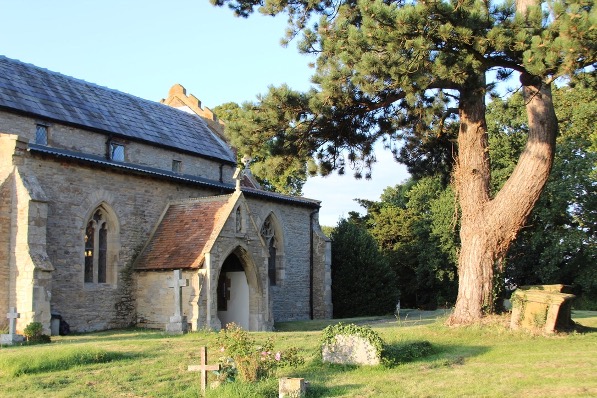 St Mary’s is a Grade 1 listed building probably developed from a 12th-century church consisting of a chancel and a nave. In the 13th-century north and south aisles were added. The church was altered again in the 14th-century when the nave arcades were raised, the aisles rebuilt, and the tower and south porch added. From 1861–90 the chancel and porch were rebuilt, and the church restored.
St Mary’s is a Grade 1 listed building probably developed from a 12th-century church consisting of a chancel and a nave. In the 13th-century north and south aisles were added. The church was altered again in the 14th-century when the nave arcades were raised, the aisles rebuilt, and the tower and south porch added. From 1861–90 the chancel and porch were rebuilt, and the church restored.
 The chancel, by William Burgess was reconstructed in 1861 but the chancel arch was constructed from a mixture of pieces from earlier times. The arch itself originates from the 13th-century and was adapted about 100 years later. It rests on a victorian oak screen which incorporates the moulded principal mullions and two traceried panels of a 15th-century screen. The posts at either end of the screen are also from the 15th-century and the one on the north side contains part of a squint (a hole cut in the post to enable members of the congregation to see the altar).
The chancel, by William Burgess was reconstructed in 1861 but the chancel arch was constructed from a mixture of pieces from earlier times. The arch itself originates from the 13th-century and was adapted about 100 years later. It rests on a victorian oak screen which incorporates the moulded principal mullions and two traceried panels of a 15th-century screen. The posts at either end of the screen are also from the 15th-century and the one on the north side contains part of a squint (a hole cut in the post to enable members of the congregation to see the altar).
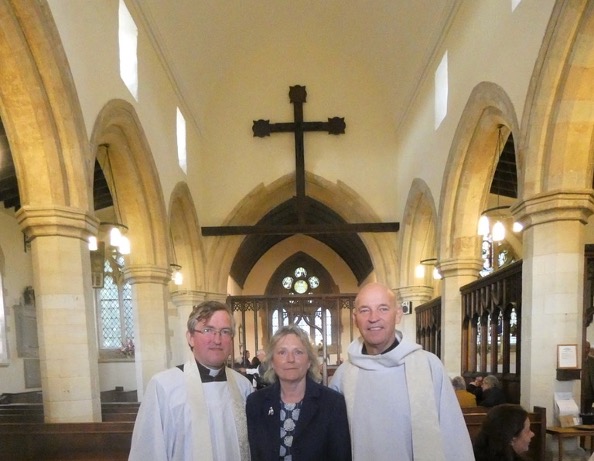 The north and south arcades of the nave both consist of four bays with pointed arches and octagonal columns. There are four clearstory windows on the north side and three on the south side, all with plain square openings and wooden lintels, with a few courses of brickwork over the heads outside; they appear to have been inserted in the 17th century.
The north and south arcades of the nave both consist of four bays with pointed arches and octagonal columns. There are four clearstory windows on the north side and three on the south side, all with plain square openings and wooden lintels, with a few courses of brickwork over the heads outside; they appear to have been inserted in the 17th century.
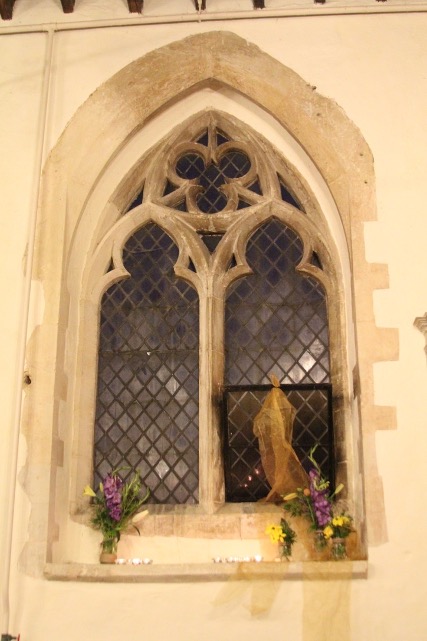 A number of the windows date from the 14th-century. Most of these have two lights but the one on the east wall of the north aisle has three as does the east facing light in the bell chamber of the tower. they are all glazed with plain glass. According to A History of the County of Buckingham: Volume 4. Originally published by Victoria County History, London, 1927, there are a few fragments of 14th-century glass in the west window of the tower.
A number of the windows date from the 14th-century. Most of these have two lights but the one on the east wall of the north aisle has three as does the east facing light in the bell chamber of the tower. they are all glazed with plain glass. According to A History of the County of Buckingham: Volume 4. Originally published by Victoria County History, London, 1927, there are a few fragments of 14th-century glass in the west window of the tower.
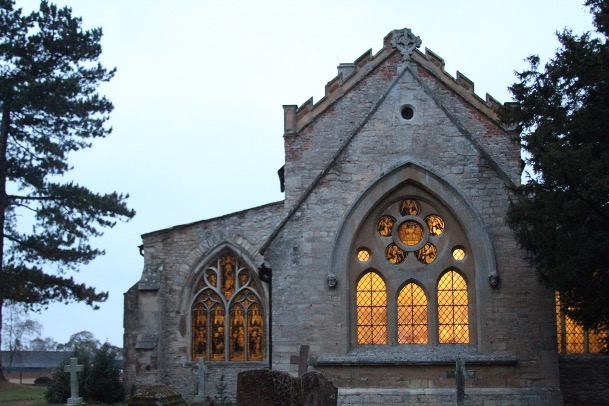 The church has three Victorian stained-glass windows, the east window, the window in the south wall of the chancel and the one at the east end of the south aisle. Burgess designed the large plate tracery of the east window which was glazed with stained glass in the rose window style section and with plain glass underneath. Apparently, this is because at the time there was a vast oak reredos which completely obscured the three main lights, and even the bottom halves of the two lower lights of the tracery. Presumably, in the interests of economy, it was felt unnecessary to have stained glass in the parts of the window which would never be seen.
The church has three Victorian stained-glass windows, the east window, the window in the south wall of the chancel and the one at the east end of the south aisle. Burgess designed the large plate tracery of the east window which was glazed with stained glass in the rose window style section and with plain glass underneath. Apparently, this is because at the time there was a vast oak reredos which completely obscured the three main lights, and even the bottom halves of the two lower lights of the tracery. Presumably, in the interests of economy, it was felt unnecessary to have stained glass in the parts of the window which would never be seen.
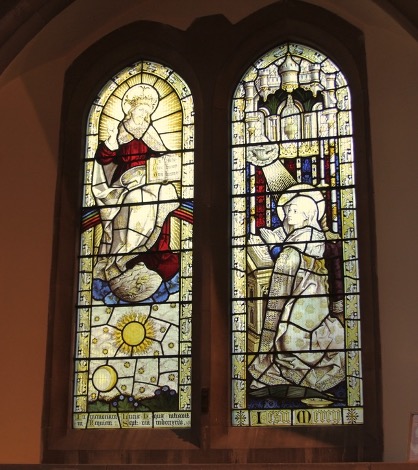 The window on the south wall of the chancel depicts the Christ in Glory and St Lucy patron saint of the blind and the east facing window in the south aisle depicts a series of significant events in the life of the Virgin Mary. The east end of the south aisle is enclosed by a late Victorian screen to form a lady chapel. All three windows were glazed by Burlison and Grylls in1895.
The window on the south wall of the chancel depicts the Christ in Glory and St Lucy patron saint of the blind and the east facing window in the south aisle depicts a series of significant events in the life of the Virgin Mary. The east end of the south aisle is enclosed by a late Victorian screen to form a lady chapel. All three windows were glazed by Burlison and Grylls in1895.
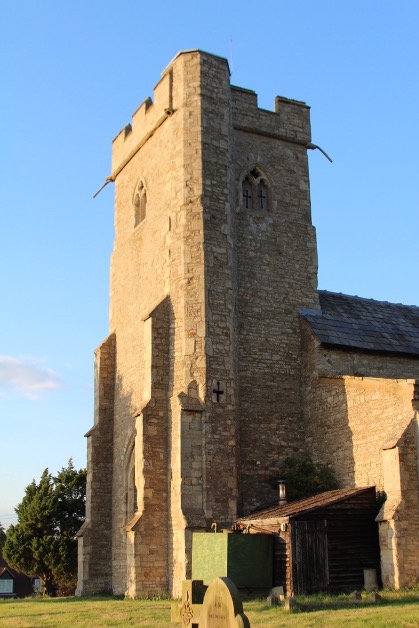 The tower is of 14th-century construction, built in two stages with diagonal buttresses, a south-west stair turret, a battlemented parapet with a string course and stone gargoyles at the corners.
The tower is of 14th-century construction, built in two stages with diagonal buttresses, a south-west stair turret, a battlemented parapet with a string course and stone gargoyles at the corners.
There are four bells: the treble by James Keene, inscribed '1640 I.K.'; the second, third and tenor all by W. & J. Taylor, Oxford, 1839.
Other significant features are the brass figures of a man and woman, thought to be Richard Ruthall 1528, in the north aisle:
“The man is represented in plate armour with a mail skirt and large knee-cops and shoulder-guards, and has a long sword hanging from his belt, while the woman wears a long gown and a pedimental head-dress. A brass shield has the arms: a cross engrailed between four martlets and a quarterly chief charged with two roses for Ruthall of Wolverton, impaling a fesse between three crescents. There are also indents of a marginal inscription, groups of sons and daughters, and three shields.”
On the north wall of the chancel are late 19th and early 20th-century monuments to members of the Carrington family, including a brass tablet with elaborate baroque surround by Lerolle of Paris for Robert 2nd Baron Carrington and one in white marble with delicate rococo style ornament by Boehm for his wife.
This information was obtained from BHO British History On-line and the Stained Glass of Buckinghamshire Churches

 St Mary’s is a Grade 1 listed building probably developed from a 12th-century church consisting of a chancel and a nave. In the 13th-century north and south aisles were added. The church was altered again in the 14th-century when the nave arcades were raised, the aisles rebuilt, and the tower and south porch added. From 1861–90 the chancel and porch were rebuilt, and the church restored.
St Mary’s is a Grade 1 listed building probably developed from a 12th-century church consisting of a chancel and a nave. In the 13th-century north and south aisles were added. The church was altered again in the 14th-century when the nave arcades were raised, the aisles rebuilt, and the tower and south porch added. From 1861–90 the chancel and porch were rebuilt, and the church restored. The chancel, by William Burgess was reconstructed in 1861 but the chancel arch was constructed from a mixture of pieces from earlier times. The arch itself originates from the 13th-century and was adapted about 100 years later. It rests on a victorian oak screen which incorporates the moulded principal mullions and two traceried panels of a 15th-century screen. The posts at either end of the screen are also from the 15th-century and the one on the north side contains part of a squint (a hole cut in the post to enable members of the congregation to see the altar).
The chancel, by William Burgess was reconstructed in 1861 but the chancel arch was constructed from a mixture of pieces from earlier times. The arch itself originates from the 13th-century and was adapted about 100 years later. It rests on a victorian oak screen which incorporates the moulded principal mullions and two traceried panels of a 15th-century screen. The posts at either end of the screen are also from the 15th-century and the one on the north side contains part of a squint (a hole cut in the post to enable members of the congregation to see the altar). The north and south arcades of the nave both consist of four bays with pointed arches and octagonal columns. There are four clearstory windows on the north side and three on the south side, all with plain square openings and wooden lintels, with a few courses of brickwork over the heads outside; they appear to have been inserted in the 17th century.
The north and south arcades of the nave both consist of four bays with pointed arches and octagonal columns. There are four clearstory windows on the north side and three on the south side, all with plain square openings and wooden lintels, with a few courses of brickwork over the heads outside; they appear to have been inserted in the 17th century.  A number of the windows date from the 14th-century. Most of these have two lights but the one on the east wall of the north aisle has three as does the east facing light in the bell chamber of the tower. they are all glazed with plain glass. According to A History of the County of Buckingham: Volume 4. Originally published by Victoria County History, London, 1927, there are a few fragments of 14th-century glass in the west window of the tower.
A number of the windows date from the 14th-century. Most of these have two lights but the one on the east wall of the north aisle has three as does the east facing light in the bell chamber of the tower. they are all glazed with plain glass. According to A History of the County of Buckingham: Volume 4. Originally published by Victoria County History, London, 1927, there are a few fragments of 14th-century glass in the west window of the tower. The church has three Victorian stained-glass windows, the east window, the window in the south wall of the chancel and the one at the east end of the south aisle. Burgess designed the large plate tracery of the east window which was glazed with stained glass in the rose window style section and with plain glass underneath. Apparently, this is because at the time there was a vast oak reredos which completely obscured the three main lights, and even the bottom halves of the two lower lights of the tracery. Presumably, in the interests of economy, it was felt unnecessary to have stained glass in the parts of the window which would never be seen.
The church has three Victorian stained-glass windows, the east window, the window in the south wall of the chancel and the one at the east end of the south aisle. Burgess designed the large plate tracery of the east window which was glazed with stained glass in the rose window style section and with plain glass underneath. Apparently, this is because at the time there was a vast oak reredos which completely obscured the three main lights, and even the bottom halves of the two lower lights of the tracery. Presumably, in the interests of economy, it was felt unnecessary to have stained glass in the parts of the window which would never be seen. The window on the south wall of the chancel depicts the Christ in Glory and St Lucy patron saint of the blind and the east facing window in the south aisle depicts a series of significant events in the life of the Virgin Mary. The east end of the south aisle is enclosed by a late Victorian screen to form a lady chapel. All three windows were glazed by Burlison and Grylls in1895.
The window on the south wall of the chancel depicts the Christ in Glory and St Lucy patron saint of the blind and the east facing window in the south aisle depicts a series of significant events in the life of the Virgin Mary. The east end of the south aisle is enclosed by a late Victorian screen to form a lady chapel. All three windows were glazed by Burlison and Grylls in1895. The tower is of 14th-century construction, built in two stages with diagonal buttresses, a south-west stair turret, a battlemented parapet with a string course and stone gargoyles at the corners.
The tower is of 14th-century construction, built in two stages with diagonal buttresses, a south-west stair turret, a battlemented parapet with a string course and stone gargoyles at the corners.